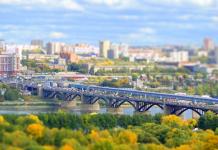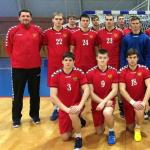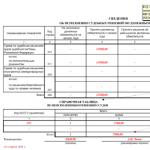480 rub. | 150 UAH | $7.5 ", MOUSEOFF, FGCOLOR, "#FFFFCC",BGCOLOR, "#393939");" onMouseOut="return nd();"> Dissertation - 480 RUR, delivery 10 minutes, around the clock, seven days a week and holidays
Popov Alexey Alexandrovich. Assessment of territorial differentiation of the quality of the urban environment of Moscow: dissertation... Candidate of Geographical Sciences: 25.00.24 / Popov Alexey Aleksandrovich; [Place of protection: Moscow. state University named after M.V. Lomonosov]. - Moscow, 2008. - 233 p. : ill. RSL OD, 61:08-11/12
Introduction
Chapter 1. Theoretical and methodological approaches to assessing the quality of the urban environment 8
1.1. The city as an object of study in economic geography 8
1.2. Evolution of approaches to the analysis of internal heterogeneity of urban areas 13
1.3. Definition of the concept “quality of the urban environment” 30
1.4. Basic principles for assessing the quality of the urban environment in Moscow 40
Chapter 2. Analysis of the results of calculating the quality index of the Moscow urban environment 51
2.1. Assessment of the quality of the situation in the transport system 51
2.2. Assessment of the situation regarding commercial and social infrastructure facilities 79
2.3. Assessing the impact of heterogeneity in the level of environmental tension
2.4. Assessment of the quality of the position relative to objects of negative and positive neighborhood 104
2.5. Analysis of the final distribution of urban environment quality index values 116
Chapter 3. The influence of the quality of the urban environment on the development of the social
stratification in Moscow 125
3.1. The territorial component of the evolution of the development of social stratification in Moscow 125
3.2. Factors indicating a possible increase in social stratification 142
3.3. Factors indicating a possible weakening of social stratification 155
Conclusion 177
References 183
Appendix 198
Introduction to the work
Relevance of the research topic. In the last two decades, large cities of the Russian Federation are going through a new stage of their development, which is associated both with a fundamental change in the economic system (the transition from a planned economy to a market economy) and with a global trend of increase; the role of non-productive sectors in the post-industrial era. All this explains the depth of transformation of their internal structure, which is currently observed - expressed in: a change in the functional purpose of urban spaces, implementation; projects for both integrated development of territories and spot development, changes in the ethnosocial composition of the population.
One of the most important results of socio-economic
transformations of the post-reform period in relation to
intra-city development began with increased polarization and growth of social tension in society, and the beginning of the process of territorial segregation of the population. The philosophy of urban development in the Soviet period, based on the desire to unify space and minimize differences between regions, has been replaced by their functioning in a market economy under the significant influence of factors of the qualitative characteristics of the environment, the cost of urban land and real estate.
The topic of a comprehensive assessment of the urban environment in the context of a change in the main vector of urban planning policy (the transition from the priority development of vacant lands to the renovation of established territories) is currently quite relevant. Geographical research methods make it possible to obtain significant results for solving scientific research and applied problems. All the latest changes in both the material and spiritual components of social dynamics are most clearly and profoundly manifested in the capital of the Russian Federation.
Analysis of intra-city differences has never been among the key areas of Russian socio-economic geography. Research work on a formal assessment of the quality of the urban environment, carried out by representatives of the Soviet school of factor ecology (Medvedkov Yu.V., Barbash N.V.) in the 1970-1980s, was not continued in the 1990-2000s. The growing interest in microgeography, noted recently, is expressed mainly in the study of individual aspects of the evolution of the components of urban systems (development of segments of the real estate market, changes in 1 ethno-social composition, environmental issues, issues of restructuring of industrial territories).
Object of study- quality of the urban environment of Moscow.
Subject of study- influence of the quality of the urban environment on the territorial component of social stratification in the capital RF.
Purpose and objectives of the study.
Target The work consists in developing methodological approaches to assessing the quality of the urban environment with the subsequent use of the obtained calculated data to predict the spatial aspect of social stratification in Moscow.
During the study, the following tasks were solved:
determination of principles and justification of methodological approaches to formal assessment of the quality of the urban environment;
development of a methodology for assessing individual components within the framework of the integral index of the quality of the urban environment, taking into account the characteristics of the territorial structure of Moscow;
analysis of territorial differentiation of the distribution of both individual parameters influencing the qualitative characteristics of the urban environment and the final index values;
determining the relationship between objective and subjective factors in pricing in the Moscow residential real estate market;
5) comparative analysis of the qualitative characteristics of the urban environment
and the territorial component of the processes that are
indicators of the development of social stratification in the capital of the Russian Federation;
To conduct the study, a combination of general scientific and geographical methods: cartographic and mathematical modeling, field monitoring studies, method of expert assessments, comparative, sociological (questioning) and historical-evolutionary methods.
Methodological and information base. The theoretical and methodological basis for the dissertation research was the works of economic geographers who specialized in studying the internal heterogeneity of urban space N.V. Barbash, O.I. Vendina, V.G. Glushkova, G.M. Lappo, E.N. Pertsika, as well as specialists in spatial development of urban systems and urban planning D. Forrester, F. Braudel, K. Lynch, R. Murphy, E. Soji, V.L. Glazycheva.
As an information base, we used materials from the Research and Development Institute of the General Plan of Moscow, specialized exhibitions on the topic of urban development, held in 2004-2008, data from the research company ESPAR-Analyst, the consulting and assessment department of Paul's Yard Realty, the results of field monitoring studies, materials from specialized Internet sites, satellite images of the city at different times.
Scientific novelty The work consists of a fundamentally different approach to a formalized assessment of the qualitative characteristics of urban space. For the first time in a comprehensive economic-geographical study of Moscow, the emphasis was placed not on assessing the heterogeneity of indicator values across administrative units, but on analyzing the fields of distribution of indicators throughout the city (without the distorting influence of the configuration and spatial dimensions of the grid of cells chosen for calculations). Basic methodological methods have been developed
principles for assessing the quality of the urban environment using a combination of systemic and environmental approaches to the object and subject of research. An index of the quality of the Moscow urban environment was calculated, including 67 private indicators, combined through an iterative procedure into 5 typological groups, the significance of which was determined based on a sociological study of the population and a survey of experts. A comparative analysis of the index values and the cost of residential real estate made it possible to identify overvalued and undervalued areas of the city in the housing market, as well as the significance of the objective and subjective components in pricing on it. Key factors were identified that are indicators of the development of social stratification in Moscow at the present time, and a forecast of this process was also given.
The obtained research results have both methodological and practical significance and allow obtaining socially significant results that can be used in regulating the territorial development of urban systems. The methodology for assessing the quality of the urban environment proposed in this work is used in applied research to develop options for the most efficient use of land in the largest cities of the Russian Federation. The calculations of the urban environment quality index for specific territories were used by Millhouse Capital in the development of concepts for integrated development of residential and commercial real estate in Omsk and Tyumen. The results of the study can be used to make management decisions in the field of long-term development of urban areas and municipalities at the local level.
Approbation of work and publication. The main provisions and results of the dissertation were reported and discussed at conferences: “B.N. Semevsky and the development of Soviet economic geography through the eyes of contemporaries and young researchers" (Smolensk, 2007), VI
International scientific and practical conference “Shevchenko Spring” (Kyiv, 2008). 9 scientific works were published on the topic of the dissertation (including 1 article in the publication of the Higher Attestation Commission list) with a total volume of 3 pp. The materials of the completed research were used when delivering individual lectures at the Department of Economic and Social Geography of Russia, Faculty of Geography, Moscow State University.
Structure! work. The dissertation consists of an introduction, three chapters, a conclusion, a list of references and an appendix. The main content of the work is presented on 169 pages of text. The list of sources used includes 215 items (of which: 187 literary sources, 11 Internet resources, as well as 17 regulatory documents). The dissertation contains 51 figures and 6 tables.
First The chapter is devoted to an analysis of the development of microgeographical research in domestic and foreign geography, as well as in a number of related disciplines. The evolution of methodological approaches to the concept of “quality of the urban environment” is considered, and the rationale for the basic principles of calculating this complex index for the city of Moscow is given.
In second The chapter provides a detailed description of the territorial heterogeneity of the distribution of individual components of the urban environment quality index. A description of the methodology for integrating intermediate and final results for each of the blocks of indicators is given. An analysis of the features of the distribution of the obtained calculated index values throughout the city is carried out.
IN third The chapter, taking into account the historical features of the development of the process of territorial stratification, as well as on the basis of a comparative analysis of the spatial component of the “external” (in relation to the urban environment) indicators of this process, characterizes the options for changing the internal structure of the city of Moscow in the medium term. The appendix provides additional information on the methodology for calculating the index and intermediate results.
The city as an object of study in economic geography
The city is one of the most complex and multifaceted objects to study in economic geography. It is characterized by the functioning of a large number of subsystems (population, economic complex, engineering infrastructure, transport), concentrated in a relatively small area. Cities are systems within large systems, formed according to certain laws at focal points of vast territories, which are concentrations of industrial, scientific and cultural values, with significant growth potential and force of attraction (Pertsik, 1999).
Many scientific disciplines (ecology, economics, urban planning) study the problems of urban environment development, but each of them approaches the issue under study from a utilitarian point of view, while geography, thanks to the combination of different scales and research methods, as well as the use of an integrated approach, is capable give a more holistic and complete assessment. In scientific research on urban topics, complex areas have developed - urban studies, urban planning, as well as urban subdisciplines (urban climatology, engineering geology, urban sociology). One of the distinctive features of geography as a science is that each of the levels of geographical research of urban areas provides answers to different blocks of questions: macroanalysis allows one to assess general trends in the development of large urban systems, the meso level - individual urban agglomerations or their groups, and when analyzing at the micro level It is possible to identify specific problems in the functioning of the city that affect the life of an individual. Various objects and phenomena “function” depending on the scale of consideration in different ways: some do not carry new information at each level, for others each of them is important. The characteristic step, the rhythm of phenomena in time and space makes it possible to identify trends and market fluctuations, displacements and pulsations of different frequencies (Treyvish, 2006).
Large cities are the epicenters of man-made problems and crisis phenomena in the economic and social sphere. The advantages of city life are often sources of conflicts of different interests. In moving towards the declared goal of improving the quality of the urban environment, it is necessary to combine opposing tasks: to preserve the diversity of places where labor is applied and to solve environmental problems that arise during production activities; to find territorial reserves for housing construction, preserving the existing volumes of areas occupied by natural complex objects
Features of urban development in modern Russia are inseparable from countrywide socio-economic transformations. The most important of them is the transition to market relations, which radically changed the features of the evolution of urban areas in our country. The placement of objects and regulations for the use of land in cities are no longer dictated from above, but are the prerogative of the “natural” development of the territory (based on a combination of the interests of business and municipal authorities).
The development of all major Russian cities is currently associated with the following complex problems:
Large-scale deindustrialization, accompanied by a radical change in the employment structure of the population and the emergence of unemployment;
Narrowing of reproduction and reduction in the size of its own population, in most cases covered by the migration influx from neighboring regions and neighboring countries;
Deep physical deterioration of engineering infrastructure; - obsolescence of urban planning and architectural planning ideas implemented in the largest Russian cities;
Transport problems associated with the explosive growth of motorization, increased mobility of the population in conditions of unpreparedness of the outdated network of city highways and public transport routes to receive an ever-increasing traffic flow;
A change in the social composition of many urban areas, accompanied by the first signs of social tension;
Overdensification of residential areas in the central part of cities, leading to the development of intra-block areas, public gardens, sports and children's playgrounds and related conflicts;
Dense development of peripheral territories, preventing the expansion of existing and construction of new transport routes, the allocation of sites for mass housing construction, for the placement of communal and social facilities. The city as an object of study has a number of features. It is a complex, but at the same time relatively weakly structured system, the main research methodology of which in most cases is system analysis. This determines the presence of a large number of cause-and-effect relationships between factors in a complex system, the result of the interaction of which is not always obvious. The city is a dynamic system, the development of which is studied in dynamics, processes are analyzed taking into account the duration of the life cycle of its structural components (population, industry, infrastructure). In addition, the city is considered as a self-regulating system in which there are internal organizational processes, and ill-considered management decisions can lead to imbalances. Therefore, in urban development there is often a conflict between long-term planning goals and short-term solutions. Good living conditions in the coming years in some cases may cause crisis phenomena in the long term.
One of the central procedures of system analysis is the construction of a generalized (unified) model of an object, reflecting the most important factors and interrelations of the system. The city as a modeling object is characterized by the following features:
Some weakness of theoretical knowledge about the object;
The lack of a general theory of urban development applicable to each specific urban entity;
The qualitative nature of much knowledge about the system, a significant share of expert assessments in the description and structuring of the modeling object (Mitichkin, 2001).
The distribution of material objects forms the spatial scheme of the city, and their relationships form the functional one. Everything is combined into the functional-spatial structure of the object. Impacts on complex and contradictory relationships that develop during functional-spatial changes are especially important in the design, development and management of complex urban systems (Resin, Popkov, 2000).
But there is another approach to the city as an object of study. According to a number of researchers, the unique in the city prevails over the typical and for its full analysis it is necessary to consider it not only as a spatial-economic, but, first of all, as a social phenomenon. The French historian F. Braudel believes that building typologies and classifications in relation to cities is pointless and that “... whatever city you take, everywhere you will see a different social structure with its own original features, its own destiny, its own peculiarity...”. He calls the goal of his analysis of the city to identify those connections that transform rural and urban areas into ordered structures. The essence of explanation in the social sciences lies in the discovery of fundamental, often unobservable mechanisms of the causal relationship of phenomena. Such invisible, unobservable structures are economic flows and their spatial distribution (Braudel, 1999). A city is determined by a set of external factors, the environment, and arises at a certain point in space, which is characterized by varying degrees of convenience of the geographical location, as well as varying intensity of economic flows. The diversity of these indicators forms the “social formulas” specific to a particular city. That is, social interactions within cities are determined primarily by external (for the city as an object of the socio-economic system) factors (Litvinova, 2002).
The above two approaches to intra-urban space as an object of study (the city as a complex structured system and the city as a unique object) are presented in various proportions in related scientific disciplines that study cities, and in various theories within the framework of geographical science.
Assessment of the quality of the situation in the transport system
The level of development of transport infrastructure and the position relative to its key elements are among the most important parameters influencing the level of attractiveness of Moscow districts. It is the indicators of transport accessibility that are of paramount importance for the development of most segments of the city’s real estate market. Due to the increase in population mobility (over the past 2 decades, the average daily travel distance has increased by 1.7 times), the influence of indicators included in this group on the quality of the urban environment has increased even more. Their significance is also important for the reason that their position in the city’s transport system indirectly affects other characteristics of the quality of the urban environment (as they determine the daily time spent on meeting human needs, and often limiting their implementation).
The weighted average duration of a weekday trip (to work or school) in one direction is 67 minutes (that is, the average Muscovite currently spends about 2.5 hours a day on the road; in addition, a fairly significant percentage of the capital’s residents spend more than 3. 5 hours, which significantly limits the possibility of carrying out any activities on a working day that are not related to a person’s main activity or travel to it). Thus, the time spent by Moscow residents in transport is only 2-2.5 times less than the duration of the working day. Therefore, within the framework of this study, special attention was paid to the transport component of the urban environment quality index, and 5 separate indicators were identified within this group.
Main characteristics of the indicators of the “position in the transport system” block.
Indicator Unit of measurement Source
No. 1 Time to reach the conditional city center in traffic jams Minutes Service "Yandex.Traffic"; traffic police data, expert survey
No. 2 Time to reach the conditional city center along free streets Minutes Author’s calculations
No. 3 Time to reach the conditional city center using public transport Minutes Data from the State Unitary Enterprise Mosgortrans, author’s calculations
No. 4 Distance to the nearest metro station Meters Author’s calculations
No. 5 Position of the cell for research relative to chord routes of public transport Calculation coefficient Data from the State Unitary Enterprise "Mosgortrans", calculations by the author
The selected indicators reflect the main features of the situation
specific points of the urban area relative to the existing transport system. The time spent on reaching the conditional city center in the morning traffic jams (these calculations were made for those using both personal and public transport; indicators No. 1 and No. 3) characterize the level of comfort of living in the area for the convenience of daily trips.
For those using personal cars, the time costs for a similar trip were additionally calculated when driving on free city highways (indicator No. 2: reflects the level of living comfort for trips on weekends and holidays, as well as during the summer decline in load on the road network).
An additional indicator of the distance to the nearest metro station was introduced (indicator No. 4). Despite some “similarity” with indicator No. 3, it reflects another feature of the area’s position relative to the transport network: the possibility (or lack of possibility) of planning the exact travel time, the need/absence of the need to use various modes of transport.
The above indicators are widely used to analyze the intra-city heterogeneity of the transport accessibility indicator, which somewhat reduces the value of these calculations, since it reflects only one component of the planning structure. Moscow - radial (that is, they estimate the time costs when moving from the periphery to the conditional center of the capital ). At the same time, the level of development of chord connections, based on the characteristics of the city’s planning scheme, is also an important factor. Therefore, within the framework of this study, a method was developed for assessing the position of areas in relation to the convenience of movement in chord directions (indicator No. 5).
The calculation of the time required to reach a conditional city center in traffic jams was carried out in several stages.
The entire territory of the city was evenly covered by a network of more than 2,300 reference points (located at the hubs of transport networks), for each of which it was planned to calculate transport accessibility to the streets located along the borders of Kitai-Gorod (along the highways Kremlevskaya Embankment - Okhotny Ryad - New Square - Old Square - Kitaygorodsky Proezd").
For each of the selected segments between reference points, using a survey of experts, monitoring the service “Yapsieh. Traffic jams" and the "START" system of the Moscow State Traffic Safety Inspectorate in 2006-2007. The average speed for movement towards the center during the morning rush hour was determined. For the convenience of developing the model, not real speed values were calculated, but a choice was made from 5 possible values (10,20,30,40 or 50 km/h), which corresponds to situations from an almost complete stop of traffic (10 km/h) to free movement with stopping only at traffic lights (50 km/h) (Fig. 2.2).
Based on the length of the segments and the speed of movement, the time required to overcome each of them was determined. For all points, the “ideal” path to reach the city center was determined (according to a reasonable ratio of time and mileage of the trip). Having summed up the duration of the trip for each segment from a specific point to the conditional center, an indicator of time costs was obtained for each of the points, then 500-meter buffer zones were built around them to assign the calculated indicator from points to cells for research. As a result, for each of the cells, the time to reach the central part of the city was obtained under the conditions indicated above (and the final indicator was obtained as the arithmetic average of the values for each of the buffer zones “covering” the cell, which made it possible to take into account the factor of the driver’s ability to choose a travel route).
class3 The influence of the quality of the urban environment on the development of the social
stratification in Moscow class3
The territorial component of the evolution of the development of social stratification in Moscow
Currently, Moscow is experiencing a period characterized by the most large-scale restructuring of urban space in its entire history. In terms of its depth and intensity, the changes noted in Moscow over the past decade and a half can only be compared with the consequences of the fire of 1812 (which led to a radical change in the nature of the capital's development) and Stalin's plan for the reconstruction of Moscow in the 1930s-1950s. Then, to achieve the goal of creating a “model communist city,” they stopped at nothing: huge industrial zones were organized; wide highways have been built; a network of high-rise architectural dominants was created, a project for “facade” development of the main radial directions was partially implemented.
Even the large-scale development of the peripheral part of the capital in the 1960-1980s (when the area of the city's territory doubled, the pace of housing construction corresponded to today's, and the volume of commissioning of engineering infrastructure facilities was ahead of them) left a smaller mark on the territorial structure of the city. The main emphasis in development in that period was focused on the outskirts of the then urban territory of Moscow15; in addition, the changes that took place were more “homogeneous” (standard residential construction, relatively uniform development of the network of trade and social infrastructure) than modern ones. Current changes affect both central regions, peripheral zones, and reserve lands. In addition, there is a change in the functional purpose of vast tracts of urban territory, the social composition of many areas is changing (moreover, the process of both intra-city migrations and migrations in the directions “Moscow - Moscow region”, “Moscow - other regions of the Russian Federation”, “Moscow - CIS countries").
The results of calculating the quality index of the urban environment can be considered as a formalized (that is, translated into digital form) characteristic of the attractiveness of various areas of Moscow for the average resident. In its composition, the distribution characteristics of not only the total values, but also the individual components are important. It is a reflection of the qualitative characteristics of certain areas, “multiplied” by the characteristics of consumer preferences noted at the time of the study (expressed in the assessment of the importance by residents of the capital of the Russian Federation and experts of certain groups of factors). In fact, its values have a significant impact on the current features of the development of intracity socio-economic processes. Among them, the most important are intra-city migrations (based on the assumption that each person is aimed at finding the most comfortable living environment for him, in which he can realize all his needs), leading to changes in the social composition of various districts of the city, as well as changes in general level of territorial heterogeneity.
To fully solve the problems posed to this study, it is necessary to add a dynamic component to the calculation of the index (which can be considered as a kind of complex multi-layer “photograph” of the city territory as of 2007). Direct modeling of changes in the values of the quality index of the urban environment within the framework of the geographical approach and geographical research methods is not possible, therefore, dynamic trends in key segments of the real estate market, as well as a territorial projection of the development of other indicators and processes with the help of which it is possible to obtain an answer to the question of intensification (or, conversely, weakening) of the process of social stratification in modern Moscow.
Urban space never “lies”; it is formed under the influence of both modern factors (both economic and sociocultural) and reflects the peculiarities of the city’s development in a historical context (Kulakova, 2006). Therefore, in order to understand and correctly comprehend the direction of the processes taking place in Moscow at the present time, it is necessary to carefully take into account the features of the centuries-old development of the Russian capital (within the framework of this study, the emphasis was placed on the features of strengthening and weakening of the social stratification of the city’s population in its spatial aspect).
The intra-city heterogeneity of the social structure of the Moscow population has a long history. It highlights both periods in which it intensified and times in which there was a desire to minimize differences. The selected time periods differ both in duration and in the main driving mechanism, and in Soviet times they even overlapped in time. The scale of influence of each period on the development of the process of territorial stratification in modern Moscow differs significantly, but their combined impact determines the complexity and multidimensionality that are characteristic of the development of the city at the present stage.
All Russian municipalities - both cities and rural settlements - where more than a thousand people live will receive an assessment of the quality of the urban environment. The methodology for determining the quality index of the urban environment was approved by order of the Ministry of Construction of Russia and on the department’s website. The Minister of Construction and Housing and Communal Services of the Russian Federation, Mikhail Men, told reporters about this on November 3.
The methodology for assessing cities was developed by the Russian Ministry of Construction jointly with AHML and Strelka KB. According to the minister, municipalities of the Russian Federation will be assessed annually using this methodology as part of the implementation of the priority project “Formation of a comfortable urban environment.”
He said that the assessment consists of two blocks: characteristics of environmental quality and criteria for assessing the effectiveness of interaction between the authorities and the population. “The Ministry of Construction will evaluate the effectiveness of the activities of regional and municipal authorities in terms of creating a comfortable urban environment, as well as the degree of participation of local residents and organizations in the development of territories of settlements,” Mikhail Men emphasized.
The head of the Russian Ministry of Construction clarified that the assessment of the quality of the urban environment consists of 41 indicators. Thirty of them were developed by AHML and KB Strelka (the first research results and description of the methodology were published on the website index-gorodov.rf), and 11 by the Russian Ministry of Construction.
In total, six types of spaces are analyzed: housing, public and business infrastructure and adjacent spaces, social and leisure infrastructure and adjacent spaces, green areas, embankments, street infrastructure and citywide space. They are assessed according to five criteria that are important for citizens: safety, comfort, environmental friendliness, identity and diversity, as well as the modernity of the environment.
Mikhail Men emphasized that the urban environment quality index will allow city authorities to set clear priorities when developing targeted development programs for their territories. For the federal authorities, the Index is an assessment of the quality of the urban environment, determining its current state, including the advantages and disadvantages of settlements, current problems, and the systematic receipt of this information will make it possible to develop qualified decisions on the development of settlements at the federal, regional and municipal levels. levels, as well as assess the effectiveness of already implemented programs and projects in this area.
The analysis is based on open sources of information - the Federal State Statistics Service, GIS Housing and Communal Services, as well as data obtained from geographic information systems and decrypted Earth remote sensing data (satellite images), as well as other open and closed sources: photographs from social networks, data, the Ministry of Internal Affairs .
By February 2018, the first document displaying the index of Russian cities will be published. Based on a study by the Ministry of Construction of Russia, AHML and KB Strelka, a Rating of constituent entities of the Russian Federation will be published annually on the website of the Ministry of Construction of Russia, taking into account both the characteristics of the quality of the environment and the assessment of the effectiveness of the government.
Where is it good to live in Rus'? The answer to this question is given by rating of Russian cities by quality of life 2017. The list was compiled by the Center for Strategic Research of the Rosgosstrakh company, which conducted a study of large cities of the Russian Federation from the point of view of the benefit of the ordinary citizen.
At the same time, several criteria were taken into account, from the state of housing and communal services and the quality of medical care to the work of traffic police officers and the alleged level of corruption of city authorities.
Read the updated year on living standards.
Table of urban environment quality indicators 2017
The share of surveyed respondents who agree that their city is convenient for living.| # | City | Housing and communal services | Cult. | Medical | Image. | Transport | Power | Corrupt |
|---|---|---|---|---|---|---|---|---|
| 1 | 89% | 93% | 47% | 91% | 83% | 78% | 19% | |
| 2 | 97% | 80% | 58% | 92% | 94% | 79% | 12% | |
| 3 | 88% | 55% | 42% | 67% | 70% | 64% | 21% | |
| 4 | 79% | 92% | 63% | 82% | 98% | 96% | 19% | |
| 5 | Orenburg | 90% | 80% | 44% | 74% | 36% | 40% | 29% |
| 5 | 86% | 81% | 34% | 96% | 48% | 48% | 19% | |
| 6 | Penza | 96% | 89% | 37% | 74% | 50% | 51% | 22% |
| 6 | 92% | 90% | 43% | 87% | 68% | 46% | 24% | |
| 7 | Voronezh | 92% | 83% | 25% | 80% | 52% | 57% | 41% |
| 7 | 90% | 82% | 31% | 71% | 77% | 70% | 20% | |
| 8 | Barnaul | 93% | 80% | 42% | 86% | 31% | 39% | 26% |
| 8 | 98% | 88% | 44% | 79% | 71% | 51% | 37% | |
| 8 | Yaroslavl | 88% | 80% | 31% | 85% | 17% | 27% | 17% |
| 9 | 97% | 91% | 37% | 93% | 59% | 50% | 11% | |
| 9 | Ryazan | 95% | 73% | 34% | 85% | 36% | 39% | 29% |
| 9 | Ufa | 74% | 83% | 37% | 79% | 44% | 51% | 32% |
| 10 | 89% | 93% | 28% | 88% | 45% | 52% | 14% | |
| 10 | Irkutsk | 88% | 78% | 32% | 76% | 39% | 43% | 11% |
| 10 | Sevastopol | 83% | 78% | 18% | 69% | 27% | 30% | 10% |
| 11 | Moscow | 83% | 83% | 42% | 79% | 73% | 61% | 24% |
| 11 | Nizhny Novgorod | 82% | 76% | 38% | 90% | 33% | 35% | 25% |
| 12 | Izhevsk | 89% | 79% | 32% | 81% | 51% | 47% | 15% |
| 12 | Samara | 81% | 72% | 30% | 80% | 38% | 52% | 39% |
| 12 | Khabarovsk | 83% | 81% | 34% | 80% | 49% | 53% | 13% |
| 13 | Lipetsk | 97% | 60% | 31% | 65% | 47% | 44% | 20% |
| 13 | Permian | 85% | 73% | 31% | 85% | 41% | 33% | 14% |
| 13 | Rostov-on-Don | 88% | 82% | 37% | 77% | 45% | 36% | 48% |
| 14 | Ulyanovsk | 93% | 70% | 40% | 83% | 40% | 47% | 19% |
| 15 | Vladivostok | 64% | 76% | 26% | 87% | 26% | 34% | 27% |
| 16 | Novokuznetsk | 83% | 73% | 36% | 68% | 50% | 57% | 18% |
| 17 | Krasnoyarsk | 95% | 85% | 39% | 88% | 45% | 42% | 33% |
| 18 | Astrakhan | 76% | 75% | 28% | 74% | 30% | 32% | 35% |
| 19 | Makhachkala | 96% | 69% | 27% | 59% | 28% | 20% | 66% |
| 20 | Saratov | 88% | 82% | 34% | 88% | 23% | 23% | 29% |
| 21 | Chelyabinsk | 92% | 78% | 33% | 86% | 40% | 22% | 30% |
| 22 | Tolyatti | 85% | 50% | 35% | 52% | 57% | 24% | 35% |
| 23 | Omsk | 85% | 78% | 36% | 81% | 38% | 24% | 25% |
| 24 | Volgograd | 78% | 52% | 27% | 76% | 31% | 36% | 39% |
10. Ekaterinburg, Irkutsk
The list of the best cities to live in Russia opens with two Siberian capitals - Yekaterinburg and Irkutsk, 85% of whose population are satisfied with their place of residence. Ekaterinburg residents believe that their city is more than sufficiently provided with cultural institutions - the city is a leader in this rating indicator.
But residents of Irkutsk are confident that the authorities of their city are the least corrupt of all. Only 11% believe in the corruption of municipal structures.
9. Novosibirsk, Ufa
 In ninth position are the capital of the Republic of Bashkortostan and the city of Novosibirsk. 86% of residents believe that these cities are generally comfortable to live in. Although Novosibirsk is the third largest city in Russia, Novosibirsk residents believe that it is sufficiently provided with housing (97%), but Ufa residents already estimate the pace of urban construction much lower (74%).
In ninth position are the capital of the Republic of Bashkortostan and the city of Novosibirsk. 86% of residents believe that these cities are generally comfortable to live in. Although Novosibirsk is the third largest city in Russia, Novosibirsk residents believe that it is sufficiently provided with housing (97%), but Ufa residents already estimate the pace of urban construction much lower (74%).
8. Yaroslavl, Barnaul, Krasnodar
 Eighth place was shared between the ancient Russian city of Yaroslavl, the administrative center of the Altai Territory Barnaul and southern Krasnodar. Despite the difference in climate, 87% of Russians consider these cities comfortable to live in. Krasnodar leads the ranking in terms of housing construction volume - the number of residents who believe that the city has enough housing for everyone reaches 98%. But residents of Yaroslavl are not at all happy with the condition of their homes and the level of work of housing and communal services - only 47% and 31%, respectively, rate them well. This is one of the lowest indicators in the ranking.
Eighth place was shared between the ancient Russian city of Yaroslavl, the administrative center of the Altai Territory Barnaul and southern Krasnodar. Despite the difference in climate, 87% of Russians consider these cities comfortable to live in. Krasnodar leads the ranking in terms of housing construction volume - the number of residents who believe that the city has enough housing for everyone reaches 98%. But residents of Yaroslavl are not at all happy with the condition of their homes and the level of work of housing and communal services - only 47% and 31%, respectively, rate them well. This is one of the lowest indicators in the ranking.
7. Voronezh, Kemerovo
 Residents of Voronezh and Kemerovo are equally satisfied with life in their cities - 89% of respondents think that living in them is not bad at all. However, in terms of the level of amenities, Kemerovo is clearly ahead of its neighbor - 90% of Kemerovo residents rate it highly, while only 70% of Voronezh residents consider their city convenient for living. But as for
Residents of Voronezh and Kemerovo are equally satisfied with life in their cities - 89% of respondents think that living in them is not bad at all. However, in terms of the level of amenities, Kemerovo is clearly ahead of its neighbor - 90% of Kemerovo residents rate it highly, while only 70% of Voronezh residents consider their city convenient for living. But as for
quality of medical care, then city residents, along with Sevastopol and Vladivostok residents, are least satisfied with it.
6. St. Petersburg, Penza
 In sixth place are two such different cities as the “northern capital” and the regional center of Penza, whose residents equally assess their standard of living in them – 90% are generally satisfied with them. Both the condition of their houses and the level of improvement of the city among Penza residents received approximately the same assessment - 73% and 72% believe that everything is not bad. But St. Petersburg residents believe that the housing stock needs to be improved (65% are satisfied with it); the level of improvement of the city, in their opinion, is quite high (82%), but the work of public utilities lags behind - only 51% of those surveyed are satisfied with them. At the same time, the Northern capital is one of the “second” cities in the world that deserve attention.
In sixth place are two such different cities as the “northern capital” and the regional center of Penza, whose residents equally assess their standard of living in them – 90% are generally satisfied with them. Both the condition of their houses and the level of improvement of the city among Penza residents received approximately the same assessment - 73% and 72% believe that everything is not bad. But St. Petersburg residents believe that the housing stock needs to be improved (65% are satisfied with it); the level of improvement of the city, in their opinion, is quite high (82%), but the work of public utilities lags behind - only 51% of those surveyed are satisfied with them. At the same time, the Northern capital is one of the “second” cities in the world that deserve attention.
5. Orenburg, Tomsk
 Fifth place in the ranking is shared by two cities - Orenburg and Tomsk, 91% of the local population is satisfied with their place of residence. Tomsk residents believe that they can get the best education in their city - 96% of residents are proud of the work of their universities; this is the highest figure among other cities. However, only 9% of residents believe that the city has a sufficient number of educational institutions. Residents suffer most from the lack of sports schools and sections, as well as preschool institutions. More than a third of those surveyed (34%) are not happy about their absence.
Fifth place in the ranking is shared by two cities - Orenburg and Tomsk, 91% of the local population is satisfied with their place of residence. Tomsk residents believe that they can get the best education in their city - 96% of residents are proud of the work of their universities; this is the highest figure among other cities. However, only 9% of residents believe that the city has a sufficient number of educational institutions. Residents suffer most from the lack of sports schools and sections, as well as preschool institutions. More than a third of those surveyed (34%) are not happy about their absence.
 92% of the population are satisfied with their life in the capital of the Chechen Republic. Grozny residents rate the condition of their homes higher than residents of other cities (79%), are proud of the level of amenities in Grozny (97%) and the condition of roads (98%). But the work of traffic police officers, according to the city population, is generally beyond praise - 95% believe that they perform their duties perfectly. But Grozny residents especially stand out based on the indicator, which is very low among the cities participating in the rating - as many as 65% of residents believe that they can influence the city government. For comparison: only 42% of residents of Tyumen, a city that follows Grozny in this indicator, believe in such a possibility.
92% of the population are satisfied with their life in the capital of the Chechen Republic. Grozny residents rate the condition of their homes higher than residents of other cities (79%), are proud of the level of amenities in Grozny (97%) and the condition of roads (98%). But the work of traffic police officers, according to the city population, is generally beyond praise - 95% believe that they perform their duties perfectly. But Grozny residents especially stand out based on the indicator, which is very low among the cities participating in the rating - as many as 65% of residents believe that they can influence the city government. For comparison: only 42% of residents of Tyumen, a city that follows Grozny in this indicator, believe in such a possibility.
 The only region of the Russian Federation from which two cities were included in the top 10 ranking of Russian cities in terms of living standards in 2017 is the Republic of Tatarstan. Naberezhnye Chelny received a place in the ranking largely due to residents’ high assessment of the work of housing and communal services - 72% of those surveyed are satisfied with it. This is the highest figure among the cities participating in the ranking. Chelny residents are also satisfied with the condition of their homes (76%), as well as the level of improvement of the city (90%), and the overall level of satisfaction is 95%.
The only region of the Russian Federation from which two cities were included in the top 10 ranking of Russian cities in terms of living standards in 2017 is the Republic of Tatarstan. Naberezhnye Chelny received a place in the ranking largely due to residents’ high assessment of the work of housing and communal services - 72% of those surveyed are satisfied with it. This is the highest figure among the cities participating in the ranking. Chelny residents are also satisfied with the condition of their homes (76%), as well as the level of improvement of the city (90%), and the overall level of satisfaction is 95%.
 Tyumen residents consider their city to be extremely favorable for life - Tyumen now ranks second in the 2017 ranking of the best cities in Russia to live in, with a population satisfaction rate of 96%. Tyumen residents rate the condition of the roads in the city especially highly (94% believe that they are good), the financial investments of local authorities in improving the city (79% of residents are satisfied with them), and the level of improvement of the city is considered very high by 93% of respondents.
Tyumen residents consider their city to be extremely favorable for life - Tyumen now ranks second in the 2017 ranking of the best cities in Russia to live in, with a population satisfaction rate of 96%. Tyumen residents rate the condition of the roads in the city especially highly (94% believe that they are good), the financial investments of local authorities in improving the city (79% of residents are satisfied with them), and the level of improvement of the city is considered very high by 93% of respondents.
 And in 2017, Kazan became the winner in the ranking of Russian cities in terms of quality of life, displacing the country’s permanent leader for several years – Tyumen. Residents of the capital of Tatarstan are extremely satisfied with the amenities of their ancient city, and compared to 2015, this figure even increased by 2% and reached 97%. Residents are pleased with the level of amenities of the city (92%), the number and level of work of cultural institutions (according to this indicator, Kazan is second only to Yekaterinburg) and the level of education (91%). The republic does not lag behind its capital and also entered the.
And in 2017, Kazan became the winner in the ranking of Russian cities in terms of quality of life, displacing the country’s permanent leader for several years – Tyumen. Residents of the capital of Tatarstan are extremely satisfied with the amenities of their ancient city, and compared to 2015, this figure even increased by 2% and reached 97%. Residents are pleased with the level of amenities of the city (92%), the number and level of work of cultural institutions (according to this indicator, Kazan is second only to Yekaterinburg) and the level of education (91%). The republic does not lag behind its capital and also entered the.
ORDER
ABOUT APPROVAL OF THE METHODOLOGY
ASSESSMENTS OF THE QUALITY OF URBAN LIVING ENVIRONMENT
In pursuance of subparagraph "d" of paragraph 1 of the list of instructions of the President of the Russian Federation dated February 29, 2012 No. Pr-534, I order:
1. Approve the attached methodology for assessing the quality of the urban living environment.
2. The Federal Agency for Construction and Housing and Communal Services (V.A. Tokarev), in accordance with the methodology specified in paragraph 1 of this order, organize an assessment of the quality of the urban living environment on an ongoing basis.
3. I reserve control over the execution of this order.
I.N.SLYUNYAEV
Application
Approved
by order of the Ministry
regional development
Russian Federation
Methodology for assessing the quality of the urban living environment
The Methodology for Assessing the Quality of the Urban Living Environment (hereinafter referred to as the Methodology) was developed to assess the quality of the urban living environment to ensure effective decision-making in the field of urban planning and housing policy.
The goal of urban planning and housing policy is to create a comfortable living environment that allows citizens to meet their housing needs and ensure a high quality of life in general. The effectiveness of such a policy increases significantly with its territorial differentiation, taking into account the socio-economic and demographic prospects for the development of regions, cities and other settlements. To develop such a policy, both at the state and regional levels, and make qualified decisions on the development of cities and other settlements, the task of assessing the quality of the urban environment becomes critically important.
This task is of particular relevance for large cities (with a population of over 250 thousand people). In total, there are about 75 large cities in the Russian Federation, home to about 53 million people. It is these cities that today are centers of socio-economic development and have the highest investment attractiveness, which in turn places increased demands on the quality of the urban environment.
International experience shows that the quality of the urban environment can be assessed in different ways, using different methods, which are based on different approaches to the interpretation of the concept of “urban environment”. At the same time, a common feature of most of these methods is the use in different combinations of a more or less constant set of indicators (both objectively measured and subjectively assessed), characterizing such areas of urban life as transport connectivity, housing conditions, accessibility of services, environmental furnishings, landscaping, safety and feeling of comfort of the urban environment by residents.
In accordance with the Methodology, assessing the quality of the urban living environment in large cities of Russia will not only identify the main problems in the development of such cities, but also identify cities with the best practices in organizing the quality of the urban living environment.
The main direction in the development of the socio-economic well-being of Russia is not only ensuring stability within the regions, but also creating the necessary conditions for economic growth in each subject of the Russian Federation, including increasing the level of investment attractiveness. One of the main problems hindering the dynamic development of the country is the significant socio-economic difference between individual centers of the Russian Federation and the depressed periphery.
Today, out of 83 constituent entities of the Russian Federation, 73 are subsidized, which confirms the presence of significant territorial heterogeneity, determined by a number of indicators. This disproportion arises due to significant differences in the standard of living of citizens and the opportunities for their personal and professional development. This situation contributes to the outflow of young people and qualified personnel from regions with a low degree of development and development, which further aggravates the trend of increasing territorial imbalances, stagnation and degradation of these territories.
The current situation is mainly due to the specifics of the Russian economy, which is focused on the export of gas and oil, and is also largely due to the uneven distribution of competitive advantages, including raw materials, demographic and financial ones. The second unresolved problem still remains the high degree of centralization of the state's budget policy, which excludes the possibility of forming a budget in accordance with the real needs of regions and municipalities. However, it is worth noting that today the state is following the path of budget decentralization, which significantly improves the socio-economic microclimate of regions and municipalities.
In accordance with the existing settlement system, cities are the support centers accumulating the resources of the territory. Thus, the share of the urban population in various constituent entities of the Russian Federation ranges from 30% to 100%, with the national average being 73.1%. Therefore, it is the improvement of urban space that is a key factor in the development of the territory of the Russian Federation and improving the quality of life of the population.
The level of interest of Russian cities in improving their economic potential, diversifying the economy and developing effective urban management mechanisms not only remains high, but also tends to constantly grow. There is also a clear trend of increased population mobility, increased business movements, educational migration, and change of residence.
Thus, the need to develop a Methodology based on comparing cities according to various parameters depending on specific goals is obvious. Just such a comparison tool is the general rating of the attractiveness of Russian cities (hereinafter referred to as the Rating), developed, according to the Methodology, by the Russian Union of Engineers on the instructions of the Ministry of Regional Development of Russia).
The selection of criteria for comparing cities in the Ranking is strictly balanced, based on comprehensive coverage of the urban economy and analysis of the living conditions of the population in the city. The calculation of indicators is carried out on the basis of a number of statistical, mathematical and qualimetric methods.
The main scope of the Rating applies to federal and municipal authorities that need information on assessing the current state of the urban economy, determining the efficiency of certain structures and the degree of implementation of specific projects or programs, as well as entrepreneurs and investors in order to make decisions on investments and investments in the territory of a particular municipality, understanding the economic and institutional climate in the territory of the municipality, assessing potential risks, etc.
Based on statistical indicators, it is possible to derive integral indicators necessary for an objective comparison of cities.
Creation of a tool that supports urban development by identifying the benefits and constraints that promote development. The integral assessment method and a set of indicators make it possible to identify the advantages and disadvantages of cities.
Development of an analytical framework that is of interest to executive authorities at various levels, business structures and the population, helping to assess the situation and make the right decision. The rating is the basis for creating comprehensive and sectoral development strategies for municipalities (cities), as well as the basis for creating regional business programs. For the population, the Rating is interesting primarily because it allows them to compare living conditions, housing affordability and other opportunities.
The Russian Federation is a country with a huge area, on the territory of which there are more than 1000 cities and towns.
Many Russians and foreign citizens are interested in the standard of living in Russia, in which city it is the highest. The answer can be found in the results of research conducted by an organization called the Center for Strategic Research, which belongs to the Russian State Insurance Company.
Sociological studies and surveys of Russians living in various cities of the Russian Federation have shown which regions are most in demand among Russian residents, and which are in less demand for living.
To understand which region is better to live in, employees of the Center for Strategic Studies asked residents of each of the regions and cities presented below about how satisfied they were with the level and quality of life in them.
City name | The share of people surveyed who confirmed that their city is the most acceptable and convenient for living in the regions of Russia (in%) |
| Kazan | 97 |
| Tyumen | 96 |
| Naberezhnye Chelny | 95 |
| Grozny | 92 |
| Tomsk | 91 |
| Orenburg | 91 |
| Saint Petersburg | 90 |
| Penza | 90 |
| Voronezh | 89 |
| Kemerovo | 89 |
| Yaroslavl | 87 |
| Barnaul | 87 |
| Krasnodar | 87 |
| Ryazan | 86 |
| Novosibirsk | 86 |
| Ufa | 86 |
| Ekaterinburg | 85 |
| Irkutsk | 85 |
| Sevastopol | 85 |
| Nizhny Novgorod | 83 |
| Moscow | 83 |
| Izhevsk | 81 |
| Khabarovsk | 81 |
| Samara | 81 |
| Permian | 80 |
| Lipetsk | 80 |
| Rostov-on-Don | 80 |
| Ulyanovsk | 77 |
| Vladivostok | 75 |
| Novokuznetsk | 71 |
| Krasnoyarsk | 70 |
| Astrakhan | 68 |
| Makhachkala | 68 |
| Saratov | 66 |
| Chelyabinsk | 64 |
| Tolyatti | 62 |
| Omsk | 62 |
| Volgograd | 60 |
The table displays the general standard of living and satisfaction of Russian citizens with their regions and cities.  But in addition to such a survey, the research center conducted social surveys on whether Russians were satisfied with the quality of the urban environment. The surveys were conducted according to the following selected criteria:
But in addition to such a survey, the research center conducted social surveys on whether Russians were satisfied with the quality of the urban environment. The surveys were conducted according to the following selected criteria:
- Department of Housing and Utilities.
- Cultural level of the city.
- Medical service.
- Educational sphere.
- Transport.
- Level of corruption.
Department of Housing and Utilities
When studying the situation with housing and communal services, many Russian citizens had to answer the question, are they satisfied with the quality of service of housing and communal services and housing prices?
Residents of Grozny, Ufa, Vladivostok, Astrakhan and Volgograd are least satisfied with housing and communal services.
Cultural level
- Kazan;
- Grozny;
- Ekaterinburg;
- Novosibirsk;
- Rostov-on-Don;
- Saint Petersburg;
- Krasnodar;
- Penza;
- Moscow;
- Khabarovsk.
Medical service
List of cities with the highest level of medical care:
- Grozny;
- Tyumen;
- Kazan;
- Barnaul;
- Naberezhnye Chelny;
- Orenburg;
- Penza;
- Saint Petersburg;
- Ulyanovsk;
- Krasnodar.
Educational field
| Share of residents satisfied with the educational sector of the Russian Federation in their city (% of the total number of respondents) | |
| Tomsk | 96 |
| Novosibirsk | 93 |
| Saratov | 88 |
| Tyumen | 92 |
| Kazan | 91 |
| Nizhny Novgorod | 90 |
| Ekaterinburg | 88 |
| Vladivostok | 87 |
| Saint Petersburg | 87 |
| Chelyabinsk | 86 |
Corruption
List of cities and regions with the highest corruption rates:

Transport sector
List of regions with the most developed transport systems:
- Grozny;
- Tyumen;
- Kazan;
- Moscow;
- Saint Petersburg;
- Tolyatti;
- Izhevsk;
- Novokuznetsk;
- Tomsk;
- Penza.
Wage
Many will agree that statistics on the standard of living of the population largely depend on the average salary of a person. According to statistics, people in Russia receive the highest wages in the following districts and cities:

- The Chukotka Autonomous Okrug ranks first in the Russian Federation in the top 10 regions with the highest salaries. According to statistics, in the Chukotka Autonomous Okrug the average salary is 71,000 rubles. The economy of this district is built on the mining industry.
- Yamalo-Nenets Autonomous Okrug. The average salary, according to statistics, is 69,000 rubles per month. Such high wages are due to gas and oil production in this district.
- Nenets Autonomous Okrug. The average salary in this district is 68,000 rubles. Basically, most of the workers of the Nenets Autonomous Okrug are involved in the forestry, food and fishing industries.
- The Khanty-Mansiysk Autonomous Okrug has an average monthly salary of 67,000 rubles. The fact that this region ranks 4th in the top is not at all surprising. According to statistics, more than 60% of the total oil production in Russia is produced in this region.
- Magadan Region. In this area, there is an annual increase in average monthly wages. In 2017, residents of the Magadan region earned an average of 66,000 rubles. This level of payment is determined by the main field of activity of the Magadan region and high labor productivity. It's no secret that this area mines gold in large quantities. But in addition to the extraction of this precious metal, the region makes good money from the fishing industry.
- The Tyumen region has taken one of the leading positions in the top thanks to its developed real estate market. In the Tyumen region, realtors and truck drivers are in great demand. On average, residents of this region earn 65,000 rubles.
- Moscow. The capital of the Russian Federation is known not only for its developed infrastructure and multi-million population, but also for its very high wage levels. In the capital, on average they receive 60,000 rubles.
- Sakhalin region. The lowest salary on Sakhalin is 16,000 rubles. But less than 20% of the population receives such a salary. On average, residents of the Sakhalin region earn 59,000 rubles monthly.
- The Kamchatka region is known for its very developed fishing industry. The financial and mining industries are also well developed in this region. The average salary, according to statistics, is 54,000 rubles per month per person.
- Yakutia (officially: Sakha Republic) is able to provide an average salary of 54,000 rubles to people living and working in this area.
The decline in GDP was influenced by the conflict between the Russian Federation and Ukraine
The first reason for the low standard of living in Russia is the decline in GDP. This is one of the main indicators of the level of quality of life and the market value of all final goods and services.
Dynamics of changes in the level of gross domestic product of the Russian Federation over the past 20 years
| Year | GDP indicator (in US dollars per capita) |
| 1998 | 2739 |
| 1999 | 1837 |
| 2000 | 1333 |
| 2001 | 1775 |
| 2002 | 2100 |
| 2003 | 2380 |
| 2004 | 2980 |
| 2005 | 4100 |
| 2006 | 5353 |
| 2007 | 6930 |
| 2008 | 9100 |
| 2009 | 11 635 |
| 2010 | 8561 |
| 2011 | 10 670 |
| 2012 | 13 320 |
| 2013 | 14 070 |
| 2014 | 14 480 |
| 2015 | 12 717 |
| 2016 | 8447 |
| 2017 | 8664 |
Based on the data in the table, we can note a sharp drop in the standard of living in Russia and its GDP. Many political scientists argue that the sharp decline in GDP was influenced by the conflict between the Russian Federation and Ukraine. Let us recall that in 2014 the Crimean Peninsula seceded, after which the Ukrainian authorities officially announced the presence of Russian military personnel on Ukrainian territory.
This statement served as the basis for the introduction of sanctions against Russia by the European Union. Due to many sanctions, Russia was unable to fully carry out trade turnover; product exports decreased significantly, which resulted in a decline in the level of gross domestic product.
According to statistics, Russia ranks 10th in the world in terms of GDP.
It's no secret that the level of GDP is affected by production volumes, and the country has very low labor productivity. This is the second reason for the low standard of living in Russia.
Low labor productivity was a consequence of worn-out infrastructure and old production equipment.
The third, but not least important reason for the decline in the quality of life of citizens of the Russian Federation is corruption, which flourishes in almost every city in the country.




















